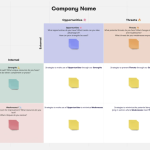In the fast-paced world of Software as a Service (SaaS), understanding your competition is crucial. This article will delve into the importance of SaaS competitor research, competitor monitoring, and competitor tracking. We will explore how these strategies can help SaaS companies stay ahead of the curve and maintain a competitive edge in the market.
Understanding the SaaS Landscape
The SaaS industry is a dynamic and rapidly evolving field. It is characterized by a high level of competition, with numerous companies vying for market share. Key players in the industry include giants like Microsoft, Salesforce, and Adobe, as well as a host of innovative startups.

Market trends in the SaaS industry are driven by technological advancements and changing customer needs. Cloud computing, artificial intelligence, and machine learning are some of the technologies shaping the industry. On the customer side, there is a growing demand for personalized, user-friendly software solutions.
Despite the opportunities, SaaS companies face several challenges. These include high customer acquisition costs, low customer retention rates, and the need for continuous innovation. Understanding these challenges is the first step in conducting effective competitor research.
The Benefits of Competitor Research
Competitor research is a powerful tool for SaaS companies. It provides valuable insights into market trends, customer preferences, and competitive strategies. By understanding what competitors are doing, SaaS companies can identify market opportunities and gaps.
Competitor research can also inform product development and positioning. By analyzing competitor products, companies can identify features that are popular with customers, as well as areas where competitors are falling short. This information can be used to enhance existing products or develop new ones that meet customer needs more effectively.
Setting Up a Competitor Monitoring System
To conduct effective competitor research, SaaS companies need to set up a competitor monitoring system. This involves choosing the right tools for competitor tracking, setting up alerts and notifications, and creating a competitor database.
There are several tools available for competitor tracking, ranging from free options like Google Alerts to paid services like SEMrush and Ahrefs. These tools can help companies track competitor activities, such as product launches, pricing changes, and marketing campaigns.
Identifying Competitors
In the SaaS industry, there are different types of competitors. These include direct competitors, who offer similar products or services, and indirect competitors, who offer alternative solutions. Both types of competitors should be included in the competitor research.

To identify competitors, companies can use market research, customer feedback, and online tools like SimilarWeb and Alexa. Once competitors have been identified, companies should analyze their strengths and weaknesses. This can provide valuable insights into competitive advantages and potential vulnerabilities.
Analyzing Competitor Strategies
Understanding competitor strategies is a key part of competitor research. This involves analyzing competitor pricing models, marketing and sales strategies, and customer support and user experience.
Competitor pricing models can provide insights into market trends and customer preferences. For example, if most competitors are offering subscription-based pricing, it may indicate a market preference for this model.
Tracking Competitor Performance
Monitoring competitor performance is another important aspect of competitor research. This involves tracking competitor financials and growth, customer acquisition and retention, and customer reviews and feedback.
Financial data can provide insights into a competitor’s profitability and financial health. Customer acquisition and retention data can indicate how effective a competitor’s marketing and sales strategies are. Customer reviews and feedback can provide insights into a competitor’s product quality and customer satisfaction.
Benchmarking Against Competitors
Benchmarking involves comparing your company’s performance against competitors. This can help identify areas where your company is performing well and areas where improvement is needed.
Benchmarking can be done in several areas, including product features and pricing, marketing and sales efforts, and customer support and user experience. The goal is to identify best practices and areas where your company can gain a competitive advantage.
Staying Ahead of the Competition
Competitor research is not a one-time activity. It should be an ongoing process, with continuous monitoring and analysis. This will allow companies to stay up-to-date with market trends and competitor activities.
By leveraging competitor insights, companies can innovate and adapt their strategies. This can help them stay ahead of the competition and maintain a competitive edge in the market.
Conclusion
In conclusion, SaaS competitor research is a crucial strategy for staying competitive in the SaaS industry. By understanding the competition, companies can identify opportunities, improve their products and strategies, and stay ahead of market trends. The key is to implement effective competitor monitoring systems and to continuously analyze and adapt based on the insights gained.
Photo by Emily Morter on Unsplash









